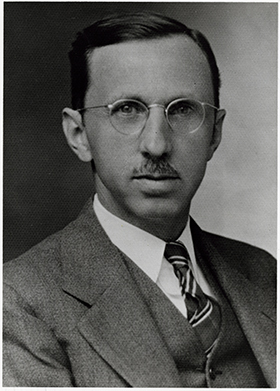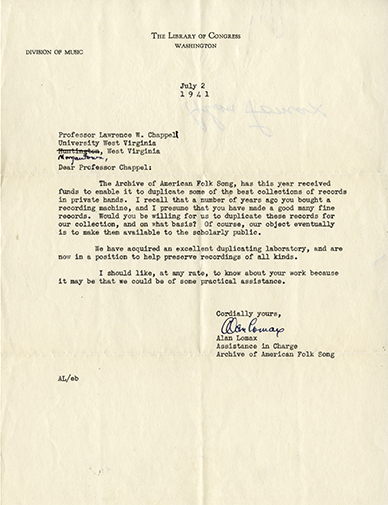About the The Chappell Collection

The Chappell Collection: an overview
The recordings for this digital collection come from the Louis Watson Chappell Archive. Louis Watson Chappell (1890-1981) was born in Belvidere, NC, educated in English Language and Literature (B.A. & M.A.), and appointed to the WVU faculty in 1922.
All the recordings were made on aluminum discs between 1937-1947 after Chappell bought a portable disc recorder. The 647 discs amount to over 2000 individual recordings including ballads of every type and topic, instrumental music, fiddle tunes, social music, game songs, gospel tunes, and Appalachian song and stories. Chappell recorded in 28 of West Virginia’s 55 counties, and two counties in Ohio, and the geographic scope of the collection is illustrated by the featured interactive map.
In the years since the collection was acquired by the West Virginia and Regional History Center in the mid-1970s, selections from the collection have occasionally been made available to the public. Fiddlers John Johnson, and Edden Hammons, patriarch of the Hammons family, were both subjects of earlier commercial releases.

Chappell as a collector and recordist
Chappell recorded using an early custom-made disc recorder. The descriptive guide to the collection notes that only a handful of these recorders were produced by the maker, and that John Lomax was among the purchasers of the other machines. Recording in the field in this era was never easy as the equipment was cumbersome and heavy. Another challenge was the availability of electricity in the rural areas where Chappell would travel to record. This meant the recording was generally not done in the homes of the performers, but in hotel rooms or in businesses, such as general stores, which had reliable electric service.
Before he purchased portable recording equipment, Professor Chappell was already a published folklorist and ballad collector, noted for his landmark 1933 study on the origins of the ballad John Henry. Word of Chappell’s interest in West Virginia ballads spread and correspondence shows students, and other contacts, sending him transcriptions of ballads. One such letter from 1925 is from the border town of Matewan, Mingo County, West Virginia, and contains the tune: “West Virginia Girls and Kaintucky Boys.”
Correspondence between Chappell and Alan Lomax shows the perceived value of the collection. In one letter, Lomax voices interest in the Archive of Folk Song at the Library of Congress possibly acquiring, or at least making copies of, Chappell’s disc recordings.
Another document in the archive provides a possible glimpse into a larger shift in Chappell’s interest in using his equipment to record more instrumental folk music, as previously his main focus appears to be the collection of ballads, mostly unaccompanied, with instrumental music appearing very occasionally on his recordings previous to 1940.
However, it appears that by 1940, Chappell was interested enough in fiddle music to be noting specific playing techniques and may have attended a fiddler’s convention that year in Union, West Virginia. This places the Summer 1940 trip during a moment of transition for Chappell as a recordist and collector of folk music. In the subsequent years, Chappell’s recording focus would shift to more fiddle music, along with the ballads and other vernacular song.

Chappell in Logan, Lincoln, and Mingo Counties
While Chappell had long been interested in the ‘Southern Coalfields’ region and its traditional music, as evidenced by the 1925 Matewan letter. It was the late summer of 1940 when Chappell was able to take a collecting trip to the three counties of Lincoln, Logan, and Mingo. It was also the only time Chappell would visit this region during his active years as a collector and recordist. It was a region where industry at the time was comprised mainly of coal mining, with some lumbering and farming as well. The lives of the performers reflect that, with some of them, such as Tom Whitt, having spent time laboring in each of these occupations.
The coal camps and company towns of this region were barely a generation removed from some of the most violent labor struggles of the West Virginia Mine Wars. It seems that no direct mention of these events is contained in the material recorded by Chappell during this trip, local events and ambience do appear. Songs are sung that mention members of the Hatfield family, and the sounds of the coal camp trains appear more than once in the background of the recordings.
Performers and Additional Resources
Additional information about some of the performers can be found in the blog Folk Music of the Southern West Virginia Coalfields, which is an ongoing documentation project by scholars Chris Haddox, a traditional musician from Logan County, and Gloria Goodwin Raheja, author of a forthcoming book on the traditional music and musicians of this region.
It provides detailed biographies and photographs of a few of the performers Chappell recorded, as well as other performers from this era and region who recorded commercially. More details about the lives and music of Kate Toney, Tom Whitt, C.C. ‘Lum’ Pack, Sarah Workman, and others are available there.
View a searchable version of the descriptive guide to the collection.
Content Warning for Potentially Harmful Language
The West Virginia Folk Music digital collection includes some content containing outdated, biased, and offensive views that may be harmful or difficult to view and hear. Descriptions provided by creators that contain harmful language are altered for the digital collection. The original records and songs have not been altered because the content provides historical context for understanding the era, attitudes, and opinions of the creators. The WVRHC is committed to assessing its descriptive practices and preventing harmful language in staff-generated descriptions.